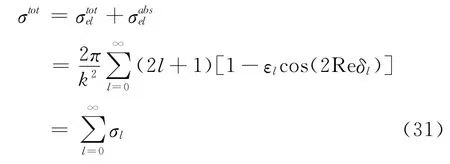Scatteringbya Complex Potential
GAO Feng,ZHANG Den-yu,XU Cheng-ke
(1.Department of Physics and Electronic Information Science,Hengyang Normal University,Hengyang 421008;2.College of Nanyue,Hengyang Normal University,Hengyang 421008)
0 Introduction
Atomic collisions phenomena are of fundamental importance in atomic and molecular physics and play alsoan important role in other fields such as astrophysics,chemistry,plasma physics and laser physics and so on.Basically,these phenomena involve collisions between an“elementary particle”(photon,electron,…)and an atomic system (atom,atomic nucleus,ion,molecule)or between two atomic systems.These all belong to the scattering problem.The methods of partial waves and Born approximation are often applied to the scattering problem.
Approximation methods are clearly neccesary in order to analyse complicated processes snch as those occurring in atomic collsions,where exact solutions are not available.Whenever possible,it is useful to first discuss approximate treatments within the framework of potential scattering,where their interpretation is simpler and their accuracy can be checked easily.But Born approximation is applicable for the high energy scattering.
The scattering cross-section be obtained by partial wavescan be considered as the problem of the computation of phase shifts,and is usually difficult to calculate phase shifts.This method is applicable for the low energy scattering.In this paper,we shall dicuss in some detail the typical problem of the quantum theory of scattering by a centre of force using the method of partial waves.
1 The method of partial waves
In general,the wavefunction at the place far away from the scattering target will contain an incident plane wave and an outgoing spherical wave which is not necessary isotropic,i.e.

where the propagation direction of the incident plane wave is chosen as the z-axis of the coordinate frame[1].For a given scattering potential,we have a concrete Schrodinger equation.Marching the asymptotic form of its solution to the expression in(1),we can determine scattering amplitude f(k,θ,φ).

The equation(2)is separable in spherical polar coordinates,we have

Where Pl(cosθ)is Legendre polynomials,the equation satisfied by the radial functions Rl(k,r)can be written


where Al(k)is real constant of integration which is independent of r.The quantitiesδl(k)which are called phase shifts,display the influence of the interaction.
2)加入特征点的TIN优化法:本方法是对离散等值线直接生成法的优化,采用加入特征点的方法来消除“平三角形”。
In addition,the first term on the right of equation(1)can be written as

To relate the scattering amplitude to the phase shifts,we use(6)to write the asymptotic form of ψ(),given by(1)as

On the other hand,the asymptotic form ofψ()can be written from (5)and(3)as

On equating the coefficients ofe-ikrin(7)and(8)we find that

Next,by matching the coefficients of eikrand using(9),we can also obtain the scattering amplitude is

which is the desired result.We remark that the scattering amplitude is independent of the choice of the“normalisation constants”Al(k).
We obtain the differential cross-section from(10)

and the total cross-section is given by

We may also write(12)as

where each partial wave cross-section σl(k)is given by

It is ctear that the method of partial waves is most useful whe only a smallnumber of partial waves contribute to the scattering.This situation occurs at low incident energies.Indeed,the“effective potential”which occurs in the radial equations(4)is

Thus,as l increases,the centrifugal barrier terml(l+1)/r2becomes more important and the incident particle needs more energe to overcome this repulsion and to probe the interaction region where the potential acts.Hence at low energies we expect that only a few partial waves will be required in the partial wave expansion[3].
2 Scattering by a Complex Potential
The scattering of a spinless paricle by a real potential V(r)in most textbooks are considered,a problem which is equivalent to the elastic scattering between two structureless particles.However,we know that when a particle collides with a target,non-elastic scattering may occur.This means that there may be one,several,or an infinite number of open channels in addition to the elastic one.As far as the elastic scattering is concerned,the presence of such non-elastic processes can be viewed as absorption from the incident beam,and taken into account by introducing a complex or‘optical’potential of the form

Theprobability continuity equation now reads

Hence,forVI>0,we have local absorption of the incident beam,the total number Nabsof particles which are‘absorbed’per unit time within the volume V being

Let us consider the particular case of a central,complex potential

Our discussion of the partial wave method is then easily generalised.The radial functionRl(k,r),
which is now complex,is the regular solution of(4),with the asymptotic form(5),whereδlmay now be complex.Let us write(5)as

If absorption takes place,the intensity of the outgoing wave must be reduced,leaving the incoming wave unaltered,and on the other hand if no absorption takes place,the intensity of the outgoing wave will remain the same as that of the incoming wave.For these reasons we must have

This suggests that we introduce complex phase shifts

so that

where the quantity

is called the‘inelasticity’or‘absorption’factor.It is clear from the above equations that Imδl≥ 0,so that

and we note that the particular caseεl=1(i.e.Imδl=0)corresponds to pure elastic scattering.
The calculation of the elastic scattering amplitudefelproceeds as in Section11.3,and we find that

The elastic differential cross-section is give by

and the total elastic cross-section is

where

We can also obtain a total absorptioncross-sectionσtotabs(also called“inelastic”or“reaction”crosssection)by computing the ration of the net ingoing flux divided by the incident flux.The result is

As we noted above,pure elastic scattering in thelth parial wave corresponds toεl=1,in which case.On the other hand,non-elastic scatter-ing(corresponding to 0≤εl<1)is always accompanied by elastic scattering.
The total (complete)cross-section including both elastic and non-elastic processes is given by

where

Upon comparison of(25)and(31),we see that the optical theorem may be generalised to read

whereσtotis the total(complete)cross-section and Im fel(k,θ=0)is the imaginary part of the elastic scattering amplitude in the forward direction.This generalised version of the optical theorem plays an important role in the analysis of complex collision processes.
[1]LI You-quan.Lectures on Quantum Mechanics[M].Hangzhou:Zhejiang University Press,2010
[2]GAO Feng,ZHOU Juan-juan,ZHANG Deng-yu.Survey on the Schrodinger equation of hydrogen atom system[J].Journal of Hengyang Normal Univeisity,2010,31(6):27-30.
[3]B.H.Bransden,C.J.Joachain.Physics of Atoms and Molecules[M].New York:Longman Inc.,1983.

